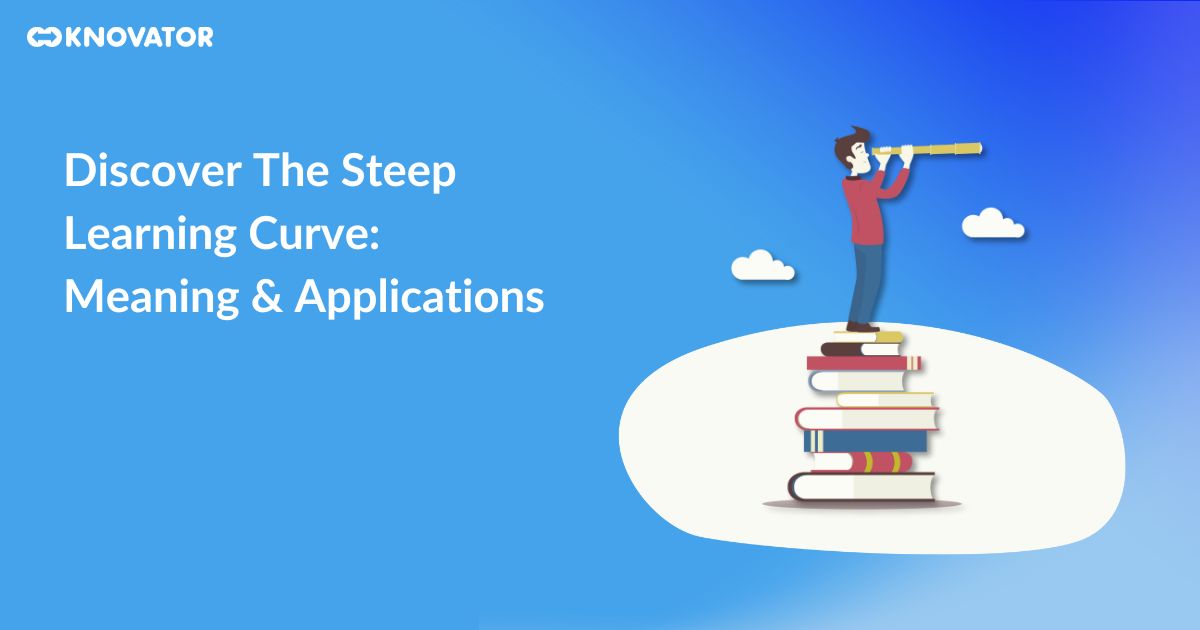Have you ever encountered something that looked hard to do, but as you kept trying, you got good at it? This phenomenon can be understood through a steep learning curve. A steep learning curve is often puzzling but presents remarkable growth and skill-acquisition opportunities.
If you are new to this concept, don’t worry; we are here to help you.
In this blog, we will study the meaning and applications of a steep learning curve, addressing its implications for individuals and industries.
What Is A Steep Learning Curve?
A steep learning curve is when someone needs to quickly pick up a new skill or information, usually in a short time. It can be tough and needs a lot of hard work and concentration, especially if their learning is tricky or unfamiliar. The word “steep” describes how fast the learning happens, beginning with a sharp incline that gets less steep as they get better and more skilled. A steep learning curve usually means facing a tough but worthwhile learning journey.
When you start learning something new, like playing a musical instrument or using complicated software, you might find it hard initially. It’s like trying to climb a steep hill – it takes a lot of effort. But as you keep practicing and trying, suddenly, things start to click. It is where the magic happens – you start getting better and understanding more rapidly. It’s like zooming down the other side of that learning hill.
In simple terms, a steep learning curve is all about learning something really hard in a short amount of time. It might feel tough initially, but with determination, you’ll get better faster than you might think. So, don’t give up when the learning hill looks steep – you’re just about to speed down the other side!
What Is The Importance Of A Steep Learning Curve?

- Fast Learning: In educational and training settings, time is often limited. A steep learning curve lets you learn a lot in a short time. It is great when you need to pick up new skills quickly.
- Skill Building: When the curve is steep, you’re pushed to practice more and improve rapidly. It helps you build strong skills and become better at what you’re learning.
- Adaptability: Learning quickly means you can adapt to changes faster. In a world that’s always changing, being adaptable is like having a superpower.
- Confidence Boost: Your confidence grows as you conquer challenges on the steep curve. You start believing in yourself and your abilities.
- Career Opportunities: Employers love people who can learn fast. A steep learning curve makes you a valuable asset in any job, giving you more chances for promotions and exciting roles.
- Problem-Solving: Steep learning often involves tackling tough problems. It sharpens your problem-solving skills, which are super handy in all aspects of life.
- Growth Mindset: Embracing a steep learning curve teaches you that failures are part of the journey. You learn to keep trying and improving, which is a growth mindset that helps in everything you do.
So, a steep learning curve isn’t just about challenges – it’s about quickly becoming a smart and skilled person ready to take on the world!
Misconceptions & Clarifications

People often refer to a steep learning curve in everyday language to indicate something difficult to learn. However, in reality, a steep learning curve signifies rapid and efficient learning, where progress occurs swiftly. The confusion arises because the analogy of a “steep hill” implies difficulty when describing the learning pace.
Importance of Understanding Correct Interpretation in Educational Settings

In educational contexts, grasping the accurate meaning of a steep learning curve enhances:
- Motivation: Students know it can be hard when they start something new and might face some difficulties. But they also understand that these challenges are normal and won’t last forever. It helps them to keep trying and not give up easily.
- Curriculum Design: Educators can design curricula that utilize the rapid progress of a steep learning curve to optimize learning outcomes in a shorter span.
- Self-Efficacy: Students recognize that their capacity to learn quickly is valuable, boosting their self-belief and self-efficacy.
- Growth Mindset: Correct comprehension encourages a growth mindset, where learners view effort and challenges as opportunities for improvement.
- Skill Acquisition: Students grasp that they’re capable of mastering complex skills efficiently, encouraging them to pursue diverse areas of knowledge.
Real-life Applications and Implications

- Optimizing Training Programs: When designing training programs, acknowledging the existence of a steep learning curve can guide curriculum planning. Knowing that initial progress might be swift, trainers can introduce more complex concepts earlier, capitalizing on learners’ rapid absorption. This approach ensures learners engage with challenging material when their learning curve is steepest, optimizing their skill acquisition.
- Enhancing Motivation: Recognizing the potential for accelerated progress cultivates a sense of achievement and motivation among learners. They comprehend that the initial hurdles are a natural part of the learning journey and that their efforts will lead to quick improvements. This knowledge boosts learners’ confidence and willingness to tackle difficult subjects.
- Tailoring Teaching Methods: Educators can tailor their teaching methods to match the trajectory of the learning curve. A more interactive and hands-on approach could be effective when learners grapple with foundational concepts. As the curve becomes less steep, transitioning to more self-directed learning can further reinforce concepts and promote long-term retention.
- Encouraging Exploration: An understanding of the steep learning curve encourages learners to explore diverse subjects. They realize that even if something seems challenging initially, rapid progress is possible with persistence. This mindset nurtures a love for lifelong learning and broadens horizons.
- Promoting Adaptive Learning: With the knowledge that progress will slow down after the initial rapid phase, learners can anticipate and prepare for plateaus. Educators can incorporate strategies like spaced repetition and varied practice to counter the diminishing steepness, ensuring consistent progress.
- Incorporating Feedback Loops: Regular feedback and assessment become more crucial during the steep learning curve phase. Constructive feedback during this period can guide learners’ efforts effectively and prevent misconceptions from solidifying.
Navigate the Path of Rapid Learning
In the learning journey, the concept of a steep learning curve serves as a guiding light. It’s not just about the initial struggle but the promise of rapid growth and skill enhancement.
Understanding that the curve’s steepness reflects quick progress and that challenges are stepping stones empowers us to embrace difficulties. This awareness is crucial in education and training, shaping effective strategies and boosting motivation.
By riding the wave of the steep learning curve, we can conquer mountains of knowledge armed with confidence, resilience, and the joy of continuous discovery.









